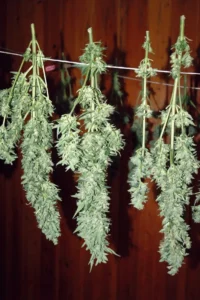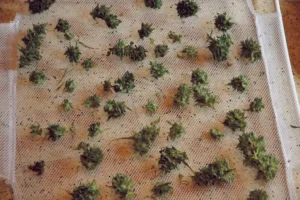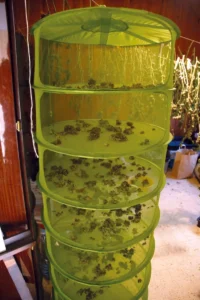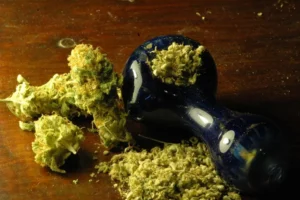Drying and Curing Cannabis Buds
Most cannabis growers quickly learn to appreciate the value of the effects and organoleptic qualities of their harvests. Ultimately, this is the measure of success for every harvest and serves as a benchmark for comparing different harvests.
Having flowers on the plant with high-quality terpenes is pointless if, after going through the drying and curing process for cannabis buds, they are not properly preserved. It is important to bear in mind that improper preservation can cause terpenes to volatilize and fail to age well, leading to a loss of many qualities, such as fragrance, trichomes, effects, and even visual appeal. In this article, we are going to delve into what is arguably the most fascinating and critical topic for most cannabis enthusiasts: the post-harvest phase.
The Drying Process
The cannabinoids present in the resin of cannabis buds do not reach their full psychoactive potential until the buds are dried. This is because the trichomes continue to mature even after the plant has been harvested. Additionally, the cannabinoids in fresh plants exist in their acidic form (THCA or tetrahydrocannabinolic acid) and need to undergo a chemical transformation called decarboxylation to become psychoactive cannabinoids (THC or tetrahydrocannabinol). The drying and curing process contributes to partial decarboxylation, which happens as the plants lose their water content.
The drying process should ideally take between 10 and 15 days to ensure optimal results. During this period, cannabis loses about 75% of its weight due to the evaporation of most of its moisture content.
The ideal location for drying cannabis is a dry and well ventilated space to allow the buds to lose moisture. It should also be a cool and dark place, since light and heat can damage cannabinoids. In reality, any well-aired space protected from sunlight can serve as a drying area, with the quality of drying depending on how optimal the parameters of humidity and temperature are in the chosen space.
There are several methods for drying your harvested flowers. In addition to mesh drying racks available at any grow shop, you can also alternatively string up lines from wall to wall to hang cannabis branches or use portable clothes drying racks, which are convenient and practical. It’s essential that the hanging plants do not touch each other to ensure optimal airflow and reduce the risk of mold. This also prevents trichomes, which are delicate, from being damaged by rubbing.
To promote uniform drying, you should use an oscillating fan to increase air circulation around the buds, but it’s important that the air does not blow directly on them.
Drying cannabis buds is fairly simple. After removing the plant’s larger leaves, you simply hang the buds upside down or lay them out on a drying rack and wait for them to dry. However, it’s crucial to monitor the process carefully. If the environment is low in humidity and air circulation is high, the buds may dry within three to five days. This is not ideal, as overly fast drying can significantly compromise the quality of the precious terpenes of your buds.
One downside of drying cannabis buds on mesh racks is that the buds may become slightly flattened, making them less visually appealing than when hung. For this reason, if you are using drying racks, it’s a good idea to turn the buds daily to ensure even drying.
Many cannabis growers tend to choose a quick drying process to be able to enjoy their buds as soon as possible. However, the truth is that the final quality of the buds is significantly better when they are dried slowly. Cannabis buds dry from the outside in, so even when they appear completely dry on the outside, they may still retain moisture internally. It is crucial to refrain from storing cannabis buds until they are fully dried to avoid the development of mold.
A reliable trick that allows the grower to know when the plants are sufficiently dry is to test the stems by bending them. The buds are at their optimal drying point when the stems snap under pressure instead of bending. An additional tip is to start testing the thinner stems, as they will snap before the thicker ones. This allows you to anticipate that buds on slightly thicker stems will be ready for curing shortly after and that the thickest stems will also snap in just a few more days.
Curing
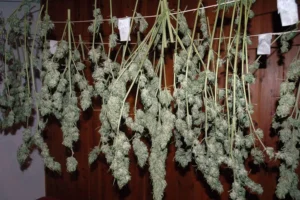
As mentioned earlier, the slower the drying process, the better the final product’s flavor will be. While the cannabis plant material retains some moisture, certain chemical reactions occur within the plant tissues, breaking down chlorophyll—the main culprit behind harsh, irritating smoke. A slow drying process allows for the degradation of more chlorophyll, resulting in a smoother flavor that stays true to the terpene profile of the cultivated strain, without being overshadowed by the taste of chlorophyll.
Drying and curing should be seen as overlapping processes that occur in succession. The breakdown of chlorophyll starts as soon as the plant is harvested and continues until the buds are consumed. In this sense, curing can even be considered to start alongside drying and lasts until the moment of consumption. However, it significantly slows down once the buds reach their optimal drying point, especially if the grower stores the buds in a place where they are protected from light, heat, and oxygen.
The grower should keep the cannabis plants hanging in the drying space until they are mostly dry but not completely dried out. The buds should be taken out of the drying space while they still retain some moisture in their center to allow for effective curing. At this stage, the drying process is slowed to a minimum by storing the buds in an airtight container, which should be opened daily to release some of the remaining moisture.
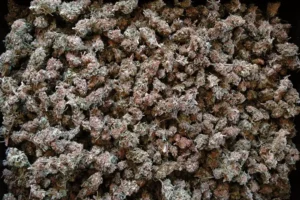
If, after being stored in airtight containers, the grower notices that the buds are holding more moisture than they should, it’s essential to take advantage of sunny days with low relative humidity by opening the containers for 1 to 2 hours. Similarly, it’s recommended to avoid opening the containers on rainy days or when humidity is high to prevent the cannabis buds from reabsorbing moisture.
A proper drying and curing process takes no less than five weeks and can extend significantly if the grower aims to achieve cannabis flowers of the best possible quality. Most strains reach their best organoleptic profile between the 6th and 10th week after harvest.
After proper drying, cannabis buds can be stored, remaining in an excellent condition for up to a year without significant loss of psychoactivity, as long as they are stored correctly. Airtight containers, preferably made of glass, are ideal for storage in a refrigerator or wine cooler, where they benefit from optimal conditions—darkness and a consistently low temperature—to preserve their important qualities, including terpene profile, smoke/vapor quality, effects, and appearance.
For optimal bud preservation beyond five or six months, freezing them in airtight glass jars (preferably vacuum-sealed) in a freezer is an excellent option, as freezing drastically slows the decomposition process to almost zero. Certain extracts, such as Live Rosin and Fresh Frozen Ice, also benefit from being stored at subzero temperatures in hermetically sealed containers to maintain the quality of the precious product.
In conclusion, if you have freshly cured cannabis buds that you know won’t be consumed for over two months, the best option is to store them well protected from air, light, and humidity, while also at a low and stable temperature. This is especially critical during hot summer months when high temperatures, low humidity, and large thermal fluctuations significantly degrade the quality of our precious cannabis flowers with each passing day.
Sweet Seeds S.L. is not responsible for any misuse of the information provided in this article. Growing Cannabis may constitute a criminal offense or administrative infraction; please check the Cannabis legislation applicable in your place of residence. Sweet Seeds S.L. does not, under any circumstances, intend to promote illegal practices.


